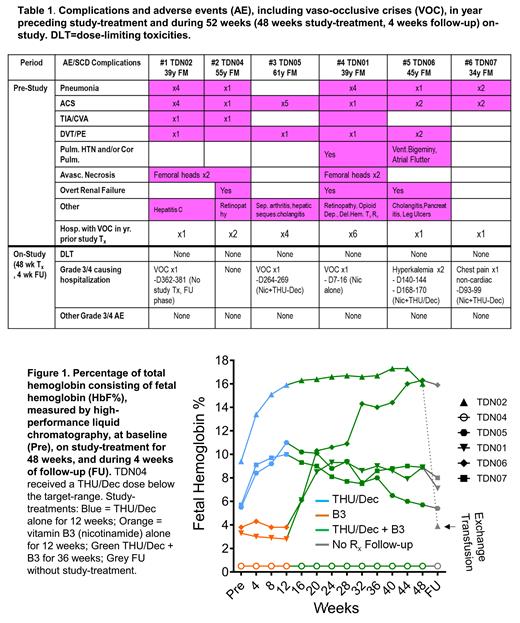Introduction: Hereditary persistence of fetal hemoglobin (HPFH) down-modulates co-inherited sickle cell disease (SCD) severity, encouraging characterization of HPFH-mechanisms for interventional reprise. One HPFH mechanism is polymorphisms in DNA methyltransferase 1( DNMT1) that decrease DNMT1 protein stability (Gong et al, Blood 2021), agreeing with biochemical observations that DNMT1 mediates repression of fetal hemoglobin (HbF) genes by BCL11A. Here we describe translation of this HPFH-mechanism into oral therapy for SCD patients at high-risk for early mortality (Steinberg et al, JAMA 2004) despite standard-treatments.
Methods and Results: The small molecule decitabine (Dec) contains a pyrimidine ring modification that binds and depletes DNMT1 and a natural deoxyribose that incorporates into DNA without terminating chain synthesis: minimum biologically effective doses of Dec, to deplete DNMT1 without cytotoxicity, can thus be found (reviewed in Zavras et al, Clin Ca Res, 2021). Other key properties of Dec are tropism to hematopoietic precursors, driven by high expression in these cells of deoxycytidine kinase that phosphorylates Dec, and rapid catabolism in vivo by cytidine deaminase (CDA), that severely restricts Dec bioavailability and half-life. We therefore combined Dec with a CDA-inhibitor tetrahydrouridine (THU): dose and schedule of THU/Dec that depleted DNMT1 without cytotoxicity to hematopoietic precursors in vivo were identified in non-human primate studies and Phase 1 clinical trials (Molokie et al, PLoS Med 2017), and here we describe interim results from proof-of-principle study in patients with SCD ( Table 1). Study interventions were oral THU/Dec (~10/0.2 mg/kg) 1X/week with or without oral nicotinamide (vitamin B3) 1 g/day. B3 was studied because it is a direct precursor of NADH, a fundamental antioxidant currency and also a cofactor for epigenetic enzymes that channel hematopoiesis to erythropoiesis vs megakaryopoiesis, to potentially counter an expected side-effect of THU/Dec of increasing platelets. Randomization was to THU/Dec vs B3 for 12 weeks, followed by THU/Dec + B3 for 12 weeks, then option to extend therapy for a further 24 weeks. Standard clinical and laboratory parameters were measured. Six patients enrolled, were randomized equally to THU/Dec or B3, and opted to extend. Dose-limiting toxicities (DLTs), including neutropenia or thrombocytosis, did not occur ( Table 1). In the year preceding study-treatment, 15 vaso-occlusive crises (VOC) requiring hospitalization were documented ( Table 1). By comparison, during 52 weeks on-study (48 weeks on-therapy, 4 weeks follow-up), the grade 3/4 adverse events were VOC hospitalizations x3 (1 during follow-up without therapy, 1 during B3 alone, 1 during B3 + THU/Dec therapy), hyperkalemia x2, and non-cardiac chest pain x1 ( Table 1)(p=0.04, paired t-test 2-sided). THU/Dec dose (7.6/0.15 mg/kg) was below the Phase 1 identified minimum biologically effective dose window (8-12/0.16-0.25 mg/kg, protocol since amended to accommodate high body weights) in one patient (TDN04) who accordingly did not have HbF% or hemoglobin increases ( Fig.1). In the 5 other patients, HbF increases (pre-treatment to maximum) were: 9.4 to 17.3, 5.9 to 11, 3.4 to 9.3, 3.3 to 16.3 and 5.7 to 10 % ( Fig.1). There were corresponding improvements in hemolysis and coagulation pathway parameters (LDH, total bilirubin, D-Dimer), and total hemoglobin increased from 9.9 to 11.5, 8.7 to 10.6, 6.6 to 7.7, 5.7 to 7.1 and 8 to 9.7 g/dL respectively. TDN01 and 06, the two patients with lowest pre-treatment hemoglobin, requested and resumed THU/Dec post-study by Expanded Access.
Conclusions: This is the longest-term treatment to date of oral THU/Dec to target DNMT1 in patients with SCD, with or without B3. Subjective and objective improvements were sustained without DLTs in high-risk patients who displayed known negative prediction markers for response to hydroxyurea (HbF% <7.5%, reticulocyte count <300 x10 9/L - Steinberg et al, Blood 1997). The safety and efficacy signals align with scientific target validation data, and together with accessibility, support relevance to SCD patient needs and goals worldwide, bearing in mind major study limitations of single-site enrollment and only 6 patients.
OffLabel Disclosure:
Saraf:Agios: Consultancy, Other: Advisory board; GBT/Pfizer: Consultancy, Other: Advisory board, Research Funding, Speakers Bureau; Forma Therapeutics: Consultancy, Other: Advisory board, Research Funding; BEAM Therapeutics: Consultancy, Other: Advisory board; Novartis: Consultancy, Other: Advisory board, Research Funding. Gordeuk:Modus Therapeutics: Consultancy; Emmaus: Consultancy, Research Funding; Forma: Consultancy, Research Funding; Novartis: Research Funding; Incyte: Research Funding; CSL-Behring: Consultancy; GBT/Pfizer: Consultancy, Research Funding; Takeda: Consultancy.
vitamin B3 (nicotinamide) to increase hemoglobin and decrease platelets THU-decitabine to increase fetal and total hemoglobin


This feature is available to Subscribers Only
Sign In or Create an Account Close Modal